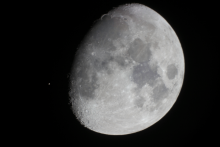Listen to today's episode of StarDate on the web the same day it airs in high-quality streaming audio without any extra ads or announcements. Choose a $8 one-month pass, or listen every day for a year for just $30.
You are here
Moon, Mars, Aldebaran
The crescent Moon has two blushing companions the next couple of nights — the planet Mars and the star Aldebaran, the “eye” of the bull. The two orange orbs are above the Moon this evening, with Aldebaran on the left and fainter Mars on the right. They’ll be below the Moon tomorrow night.
Mars and Aldebaran are rare spots of color in a basically monochrome sky. Most objects are so far and faint that we don’t see any color from them at all.
Mars and Aldebaran produce their color in completely different ways. Mars’s tint comes from dust. The dust contains a lot of iron oxide — the compound that gives rust and blood their reddish color. In fact, Mars got its name from that color. It reminded ancient skywatchers of blood, so they named it for the god of war: Ares in Greece, and Mars in Rome.
Martian winds blow the powdery dust around much of the planet, giving it an overall rusty patina — something not seen on any other world.
Aldebaran’s color, on the other hand, is quite common — it’s shared by many other stars.
Aldebaran is nearing the end of its life, so it’s puffed up to giant proportions. As its outer layers of gas expanded, they got cooler. At their current temperature, Aldebaran shines brilliant orange. Many stars have a similar temperature, so orange stars are quite common. Unfortunately, though, most of them are so faint that the eye doesn’t pick up that color, so the stars look white.
Script by Damond Benningfield



